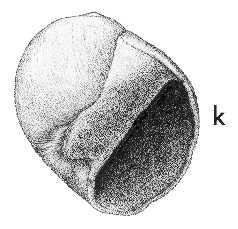
Revised descriptions of New Zealand Cenozoic Mollusca from Beu and Maxwell (1990)

 | Revised descriptions of New Zealand Cenozoic Mollusca from Beu and Maxwell (1990) | 
|
  (Pl. 20k): GS5592, J39/f6479, White Rock River, Altonian (GNS) |
Beu & Maxwell (1990): Chapter 11; p. 192; pl. 20 k.
Synonymy: Natica solida "Sowerby" of Hutton 1873b, p. 9 (not of G.B. Sowerby I, 1846, nor of Blainville, 1825); Natica (Neverita) gibbosa Hutton 1886a, p. 334 (not of Lea, 1833) (new name for Natica solida Sowerby of Hutton, 1873, preoccupied); Polynices huttoni Ihering 1907, p. 154 (new name for Natica gibbosa Hutton, 1886, preoccupied)
Classification: Naticidae: Poliniceinae
Description: Size moderate to very large for genus (height 30-65 mm), subglobose, ovate or subcylindrical; spire low, broadly conical, c. 0.1 total height. Protoconch low, of about 2.5 very weakly inflated, smooth, low whorls, not clearly differentiated from teleococonch. Teleoconch of 3-4 rapidly expanding whorls, spire whorls gently convex, last whorl typically somewhat flattened on sides, base convex. Well preserved shells with fine spiral grooves and weak ridges, otherwise smooth except for growth lines. Aperture large, semilunular, inner lip almost straight, heavily callused; parietal callus thick, spreading to a varying degree into umbilicus, almost completely filling it in some individuals, but leaving a shallow hollow or a chink in others. Outer (left) edge of callus almost straight in a few shells, but usually somewhat concave or obtusely angled, some shells with a short triangular lobe near middle. A short, shallow groove running obliquely from near base of umbilical callus towards aperture. Outer lip gently convex, rather thin and so damaged on most specimens.
Comparison: No fewer than 19 species of Polinices, ranging in age from Wangaloan to Recent, have been described from New Zealand, and their relationships are for the most part poorly understood. P. huttoni seems to be characterised by its relatively large size, its low spire, its weak spiral sculpture, its heavy callus that almost fills the umbilicus, and its tendency for the sides of the last whorl to be flattened (although this is often noticeable on only large shells). P. mucronatus (?Lillburnian, Tongaporutuan) seems to be closely related to P. huttoni, differing in its smaller size (height about 30 mm), in having callus filling the umbilicus to a greater extent (though this is not consistent), and in having a deep groove separating the abapical end of the callus from the inner lip margin. The status of P. intracrassus (?Lillburnian-Tongaporutuan, "Castle Point", Wairarapa — probably really from the Mangapakeha Valley, west of the Cretaceous "taipos", east of Masterton) is unclear. The lectotype is a bizarre shell with a flattened apex, a minute spire, which is almost involute, and an exceptionally heavy parietal callus. It is much broader from left to right (in apertural view) than from front to back. Similar shells occur in the Lillburnian (e.g. the one figured by Marwick 1931, pl. 8, fig. 148, as P. huttoni) and Waiauan (Lower Waipara Gorge) where they accompany more or less typical specimens of P. huttoni. They may therefore merely represent an extreme morphotype in the P. huttoni population, but it must be stressed that none of the numerous specimens of Polinices available for study from Altonian localities (e.g. White Rock River; Sutherlands) even begin to approach the extreme form of P. intracrassus, and few or none seem to occur in post-Waiauan rocks.
Polinices is represented in the Recent New Zealand fauna by P. tawhitirahia Powell, 1965 (Northland, also Norfolk Island), but there are no records from the Nukumaruan or Castlecliffian, suggesting either that the genus was at that time confined to northernmost New Zealand (where no sediments of this age are known — the more probable alternative) or that the genus became extinct here and then arrived again recently. Most overseas records of Polinices are from subtropical or tropical regions, where it crawls buried in sand in shallow water (e.g., in sheltered intertidal sand flats) and is a predator on other molluscs, particularly infaunal bivalves, which it perforates with its radula, leaving a characteristic borehole in the shell.
Distribution: Altonian-Lillburnian, possibly younger; "Broken River", Altonian? (type locality of N. gibbosa and P. huttoni — probably basal shellbed, Enys Formation, but precise locality unknown) and from very numerous localities in the North and South Islands, in shallow-water sandstone or shellbeds. Very common at some localities (e.g. Sutherlands). The stratigraphic range is very imperfectly known because of the difficulty of identifying fossil Polinices species confidently when only one or two indifferently preserved specimens are available.
Cite this publication as: "A.G. Beu and J.I. Raine (2009). Revised
descriptions of New Zealand Cenozoic Mollusca from Beu and Maxwell (1990). GNS
Science miscellaneous series no. 27."
© GNS Science, 2009
ISBN
978-0-478-19705-1
ISSN 1177-2441
(Included with a PDF facsimile file
copy of New Zealand Geological Survey Paleontological Bulletin 58 in CD version
from: Publications Officer, GNS Science, P.O. Box 30368 Lower Hutt, New
Zealand)